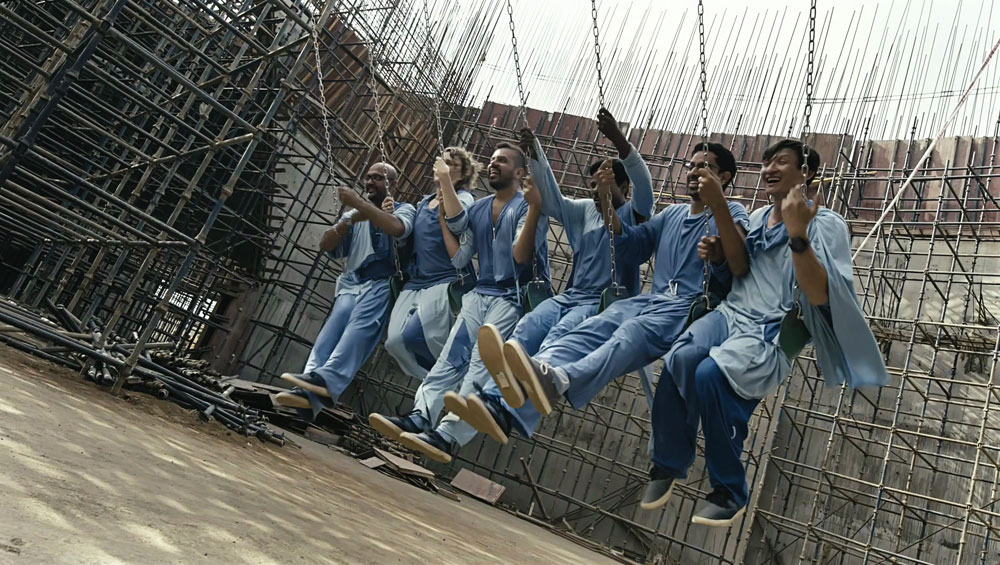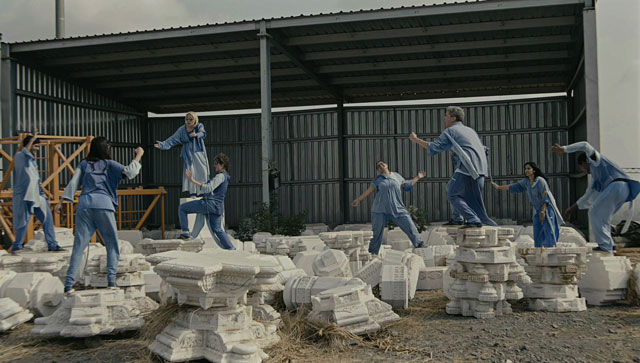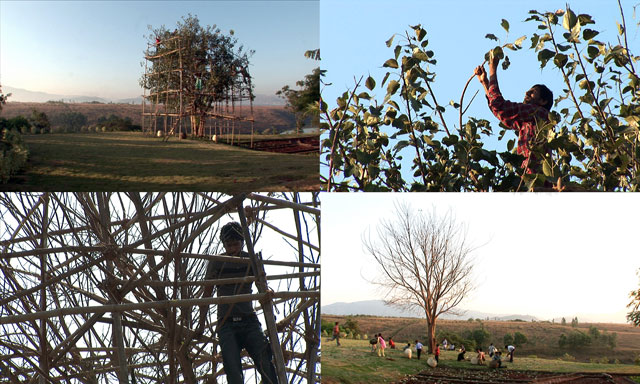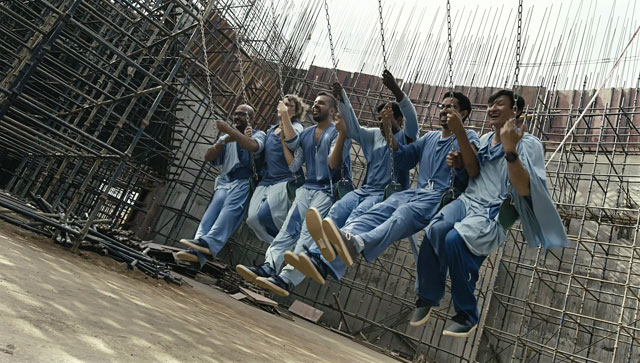
by ALLIE BISWAS
Neha Choksi works in the mediums of painting, performance, photography, sculpture and video. Her practice focuses on creating simple situations that are activated by physical actions and that ultimately conclude in absence or erasure, whether through a literal removal or stripping away, or an elimination of consciousness. Transcience and transformation are at the heart of these encounters. The artist herself frequently appears at the centre of each undertaking, although is always supplemented, whether by farm animals in Minds to Lose (2008-11), the physical touch of another human in Close (the distance) (2011), a lake in Iceboat (2012-13), or camellia trees in In Leaf (Primary Time) (2016).

Neha Choksi. ICEBOAT (video still), 2013. HD, colour, widescreen, sound, 13 min 17 sec. Video still courtesy the artist.
While presence – being alive and life itself – has been valued in Choksi’s work precisely through the generation of its opposite, the artist’s recent video installation Faith in Friction (2017), now showing at Manchester Art Gallery, is more open-ended in its execution. Throughout the course of seven individual videos, Choksi and several of her friends fill the frame, interacting together on a construction site for a Jain ashram, a good four hours north of Mumbai. Dressed in shades of blue, drapey, utilitarian outfits, the group collaboratively ride swings, eat fruit and play cat’s cradle-style games, while roaming between scaffolds and piles of bricks. Their facial expressions reveal amusement and their bodies meet and separate during the course of their activities. Through this project, the artist wanted to consider the limits of independence and alliance, as well as explore how, as individuals, we learn to be ourselves through our relationships with friends. Faith in friction shows how friendship can function, and its various layers, although the work also suggests that these displays of physical and emotional synthesis are not necessarily tangible or measurable in terms of their impact on an individual. What the work most succinctly demonstrates, perhaps, is the rapport that can be transmitted within a human network.

Neha Choksi. Video still from Faith in friction, 2017.
7-channel 4K video installation transferred to HD, each channel with stereo sound, 36 min loop. Courtesy the artist and Project 88.
Choksi was born in New Jersey in 1973, but grew up in Mumbai. She returned to the US to study Greek and Latin, in conjunction with fine art, at the University of California, Los Angeles, later studying for a master’s at Columbia University in New York. The artist now lives and works in Los Angeles and Mumbai. Given the lyrical qualities that permeate her work, it is not surprising to learn that many of the reasons why Choksi became interested in the classics are the same as those that informed her desire to be an artist. “It is an overlapping Venn diagram with a poetic sensibility probably at the core of it all,” she says.
Faith in friction is presented as part of New North and South, a three-year programme of exhibitions and commissions by a network of 11 arts organisations from across the north of England and south Asia. In 2018, Choksi will present work at the Dhaka Art Summit, Bangladesh, and 18th Street Arts Center, Los Angeles.
Allie Biswas: The Hayward Gallery introduced your work to a UK audience in 2015 through a series of three video works, Trilogy on Absenting (2007-13). I wanted to start with this, as I think it outlines important features about your work. Many of your projects rely on one critical action that directs the consequent atmosphere of the piece. Leaf Fall (2007-8), the first in the trilogy, starts with the act of picking leaves from a tree; the second, Minds to Lose (2008-11), evolves from a group of participants being sedated; and, finally, Iceboat (2012-13) centres on you rowing a boat made of ice. These videos are like one-act compositions. I particularly think of your work in this way given that, after the initial physical action – the picking of the leaves, the rowing of the boat – the subsequent stages of the work reveal themselves through physical inaction (sedated bodies) or through the realisation of absence (one leaf left on the top of the tree).
Neha Choksi: Trilogy on Absenting (Leaf Fall, Minds to Lose and Iceboat) shown at the Hayward – along with In Leaf (Primary Time) – spelled out an important aspect of my practice, in the experience of absentings and self-erasure, of blotting out all reality but that psychologically engaging one. And I tried to reach for it in memorable and succinct ways. The year before I shot Leaf Fall, I had worked on a few films for India’s entry to the Venice Architecture Biennale in 2016, and, in one of them, I had sort of transfused reality with fiction and impregnated fiction with reality. That dual ethos permeated everything I did in the trilogy. On the one hand there was a sacred tree, on the other hand was the invented ritual of plucking all the leaves (as in Leaf Fall). We are all enslaved in some way in our daily lives, so how about taking a conscious break through unconsciousness (in Minds to Lose)? A lake needs a boat, but what if I supplied a boat made of ice and rowed it myself (Iceboat)?

Neha Choksi. LEAF FALL (video stills), 2008. HDV, colour, widescreen, sound, subtitles 14 min 15 sec. Video still courtesy the artist.
Those were the sorts of things that defined the parameters of the work. Of course, the result of the action is fairly predetermined in a way. But how I get there, how I construct the edit of the film, how you absorb the particularities and materialities of the action – that is where the artwork resides. But the intertwining of an emotional experience that overlays the regular lived reality, that was probably my aim – that shift in self that one experiences when the loss converts to something that transcends the mere material transformations.
AB: If elements of your work have been focused on acts of expiration and a lack of existence, then I wonder what role people play; specifically, how does the inclusion of your friends in Faith in friction make an impact?
NC: There were other lives included from the very beginning in my work, whether they were other people, a plant or a tree, or a host of animals. And, in this way, I was always exploring the interdependencies and rifts between a self and the other. In earlier works, the cultural or social, or even personal, contexts from which the work grew is not evident, and the act of imagination resided in a fairly intellectual and emotional zone. But over the past year or so, my work has been rooted further and further in various strands of my contexts: those of my childhood, my family’s religion, my immediate sociopolitical contexts and my relationships with people. Transformations necessitate lost pasts and renewals of future hopes.
If, earlier on, my work came from an exploration of non-attachment (aparigraha in Jainism), it was always done in very clearly material terms, and it was always clear that, philosophically, I am examining absence as a materialist. Increasingly, I am blending that interest in loss and transcience with an interest in multivalency (anekantavada in Jainism). I am basically embracing my intellectual interests in personal ways.

Neha Choksi. Faith in friction, 2017. 7-channel 4K video installation transferred to HD, each channel with stereo sound, 36 min loop. As installed at the Manchester Art Gallery. Photograph: Neha Choksi. Courtesy the artist and Project 88.
In Faith in friction, I am starting from a position contra to most western therapeutic models that are invested in sufficient independence of self. I believe we are all born free and quickly learn to depend on the parental figure and then on others through our childhood. Then, somewhere in the thrust to become an adult, we uncouple ourselves from dependencies, lambast any codependencies and downplay any interdependencies. There is a need in this awful age of the human co-option of the planet to emphasise our interdependencies, to form bonds, to submit ourselves to the friction that any honest engagement requires. I am acknowledging the limits of both independence and interdependence in complicated ways by creating freewheeling moments of friction, of engagement, of harmony and synthesis, between myself and my friends.
AB: Faith in friction is set at a construction site for a Jain ashram in India. Was the workdetermined at the start by the ashram setting, or was this something that evolved after coming into contact with the physical site?
NC: Space leaves a strong experiential trace in me. I like experiencing space as a material thing, as well as an abstract symbol exploiting its generic status. Site can be interpreted in generic terms – a pastoral scene or a construction site – or in particular terms – my studio in Los Angeles or a particular Jain ashram. Faith in friction continued to evolve in my head from the first glimmers I had of it a year ago. I knew I wanted to work on that site ever since my friend told me about it, about four or five years ago, because it was an anomaly. Jains don’t have secular gurus or ashrams, they have mendicant ascetics who travel daily, save for monsoons when they stay in places donated by secular people for their transit. This ashram has a charismatic guru who is trying to bring Jainism to the youth, to make it ready for the 21st century. And part of that move includes hiring the forward-thinking company Serie Architects to design their new ashram. Also, about 10 years ago, I had been thinking about psychological testing and its triumphs and failures and, in particular, about projective personality tests, such as the one in which you draw a house, a tree and a person (the H-T-P test). Somehow all my thinking came together to create this exploration of group interdependencies on this symbolic location.

Neha Choksi. Video still from Faith in friction, 2017.
7-channel 4K video installation transferred to HD, each channel with stereo sound, 36 min loop. Courtesy the artist and Project 88.
AB: Faith in friction will expand to become a nine-channel work in the coming months, so the site will also grow in that way.
NC: It will continue evolving into the epilogue that I will work on this year, an animation that includes friends who couldn’t make it to site and their ideas for actions. Also, the work will always contain within it the seeds for other possible edits – after all, the editors got almost 34 hours of footage and each edit is unique in its approach and resolution – and hence will remain ever-expanding conceptually.
AB: How did you choose the people who participated in the work, and what did you ask of them when you invited them to play a part?
NC: I sent out an email to all manner of friends and I also talked to friends over the phone or in person. As I noted in my initial email asking for participation: "If you are getting this email, it is because you touched my life at some point in a deeply meaningful way.” I was lucky that so many friends were willing to come at such short notice. I had a relatively short timeline from the time I gained permission to shoot on location at the ashram to the dates the ashram scheduled me to be on location with crew.
I included friends from various nodes of my life: I tried to include a friend each from undergrad, from graduate school, from my time living in New York, and from my recent move back to Los Angeles. None of my friends from the US knew each other. And many of the friends in Bombay did not know each other, either. The architect of the ashram, who is one of my closest friends, was present. I also included my first friend, if you will, my brother.
Naturally, many friends were unavailable and I could not afford to fly so many in. These friends sent in contributions, as suggested by me: "A word, an action, a fragment, an idea for an activity, all can work. It can take the form of recorded conversations, email, suggestions for IRL (in-real-life) props, sculptures or actions, provocations in words or verbal ideas for the shoot.” I altered some of these activities to create engaging situations: some can be identified as based on a missing friend's suggestions, but some were so tangentially inspiring that one would be hard pressed to find the connection. Moreover, many of these suggestions will end up in an animation that is still to be created as an epilogue channel. I want a dense web of new interconnections to be born as a result of my interdependencies on and with friends.

Neha Choksi. Faith in friction, 2017. 7-channel 4K video installation transferred to HD, each channel with stereo sound, 36 min loop. As installed at the Manchester Art Gallery. Photograph: Neha Choksi. Courtesy the artist and Project 88.
AB: Once you were all on the site, what directions were given for how to behave? Was it a case of you inventing situations for everyone to take part in, or was it more improvised?
NC: Everything that happened on location was improvised, even if the prompts or locations were pre-decided or fixed, based on my invented situations. Very few directions were given about how to behave, either from me or from my good friend Karan Makhija, the on-location proxy director helping to realise my vision. A task may be set – such as gargling water – but the how was left to each person to figure out on their own. Interdependency was a running thread throughout.
AB: Finally, the clothes, those blue outfits that you all wear. Can you elaborate on this choice?
NC: Blue. Sky-clad. A word that evokes many things in addition to the immediate link to Jainism for those in the know. I knew I wanted clothes that have multiple apertures for several heads to poke through and multiple sleeves for many arms, with sashes and carabiners to allow the possibility of interconnecting.
• Neha Choksi is at Manchester Art Gallery until 25 February 2018.